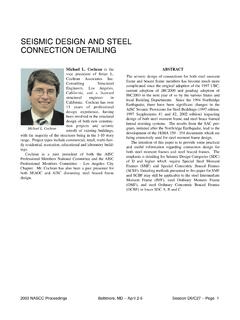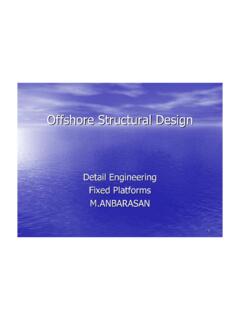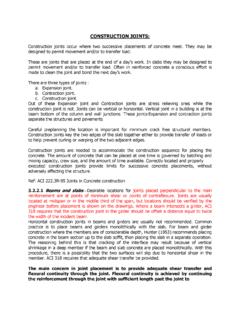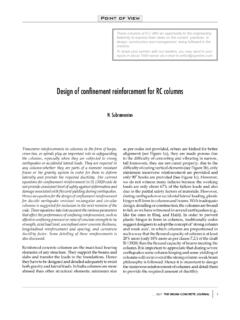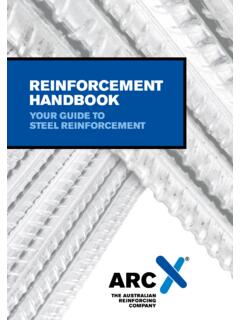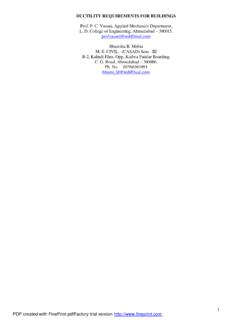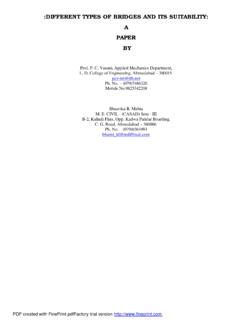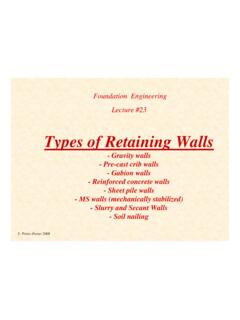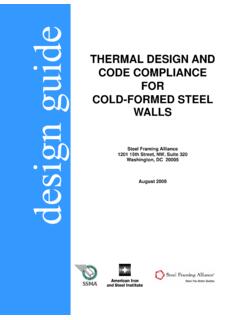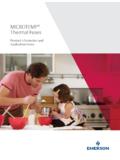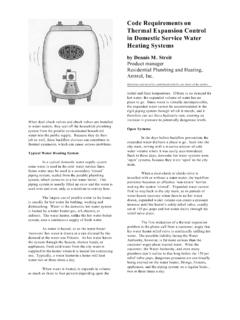Transcription of Design of Structural Steel Pipe Racks - sefindia.org
1 ENGINEERING JOURNAL / FOURTH QUARTER / 2010 / 241 Design of Structural Steel pipe RacksRICHARD M. DRAKE and ROBERT J. WALTERABSTRACTPipe Racks are structures in petrochemical, chemical and power plants that are designed to support pipes, power cables and instrument cable trays. They may also be used to support mechanical equipment, vessels and valve access platforms. pipe Racks are non-building structures that have similarities to Structural Steel buildings. The Design requirements found in the building codes are not clear on how they are to be applied to pipe Racks . Several industry references exist to help the designer apply the intent of the code and follow expected engineering practices. This paper summarizes the building code and industry practice Design criteria, Design loads and other Design consideration for pipe : non-building structures, pipe , Racks , support, designPipe Racks are structures in petrochemical, chemical and power plants that support pipes, power cables and instru-ment cable trays.
2 Occasionally, pipe Racks may also support mechanical equipment, vessels and valve access platforms. pipe Racks are also referred to as pipe supports or pipeways. Main pipe Racks transfer material between equipment and storage or utility areas. Storage Racks found in warehouse stores are not pipe Racks , even if they store lengths of allow maintenance access under the pipe rack , trans-verse frames (bents) are typically moment-resisting frames that support gravity loads and resist lateral loads transverse to the pipe rack . See Figure 1 for a typical pipe bent. Al-though the bent is shown with fi xed base columns, it can also be constructed with pinned base columns if the supported piping can tolerate the lateral transverse frames are typically connected with lon-gitudinal struts. If diagonal bracing is added in the vertical plane, then the struts and bracing act together as concentri-cally braced frames to resist lateral loads longitudinal to the pipe rack .
3 See Figure 2 for an isometric view of a typical pipe the transverse frames are not connected with longitu-dinal struts, the pipe rack is considered to be unstrutted. The frame columns act as cantilevers to resist lateral loads longitudinal to the pipe M. Drake, , SECB, Senior Fellow, Structural Engineering, Fluor Enterprises, Inc., Aliso Viejo, CA (corresponding author). E-mail: @fl J. Walter, , , Principal Civil/ Structural Engineer, CB&I Steel Plate Structures, Plainfi eld, IL. E-mail: 1. Typical transverse frame (bent). Fig. 2. Typical four-level pipe rack consisting of eight transverse frames connected by longitudinal 2412/21/11 4:53 PM2/21/11 4:53 PM242 / ENGINEERING JOURNAL / FOURTH QUARTER / 2010 Design CRITERIAIn most of the United States, the governing building code is the International Building Code (IBC) (ICC, 2009).
4 The scope of this code applies to buildings and other structures within the governing jurisdiction. The IBC prescribes struc-tural Design criteria in Chapters 16 through 23. These de-sign criteria adopt by reference many industry standards and specifi cations that have been created in accordance with rigorous American National Standards Institute (ANSI) reference, many loads are prescribed in ASCE 7 (ASCE, 2006). Similarly, most Structural Steel material ref-erences are prescribed in AISC 360 (AISC, 2005b). Most Structural Steel seismic requirements are prescribed in AISC 341 (AISC, 2005a) and AISC 358 (AISC, 2006, 2009).The IBC and its referenced industry standards and specifi -cations primarily address buildings and other structures to a lesser extent. Design criteria for non-building structures are usually provided by industry guidelines.
5 These guidelines interpret and supplement the building code and its refer-enced documents. In the case of pipe Racks , additional de-sign criteria are provided by Process Industry Practices, PIP STC01015 (PIP, 2007) and ASCE guidelines for petrochem-ical facilities (ASCE, 1997a, 1997b). In this article, the IBC requirements govern. The aforementioned industry stan-dards and specifi cations apply because they are referenced by the IBC. The PIP practices and ASCE guidelines may be used for pipe Racks because they supplement the IBC and the referenced industry standards and specifi cations. How-ever, the PIP practices and ASCE guidelines are not code-referenced LOADSDead Loads (D)Dead loads are defi ned in the IBC as the weight of materi-als of construction .. including, but not limited to .. struc-tural items, and the weight of fi xed service equipment, such as cranes, plumbing stacks and risers, electrical feeders.
6 Dead loads are prescribed in the IBC Section 1606, with no reference to ASCE 7 or any industry standard or specifi PIP Structural Design Criteria prescribes specifi c dead loads for pipe Racks . pipe Racks and their foundations should be designed to support these loads applied on all available rack space, unless other criteria is provided by the client. Structure dead load (Ds): The weight of materials forming the structure and all permanently attached appurtenances. This includes the weight of fi re pro-tection material, but does not include the weight of piping, cable trays, process equipment and vessels. Operating dead load (Do): The operating dead load is the weight of piping, piping insulation, cable tray, pro-cess equipment and vessels plus their contents (fl uid load). The piping and cable tray loads may be based on actual loads or approximated by using uniform loads.
7 The PIP Structural Design Criteria recommends a uniformly distributed load of 40 psf for pipe , which is equivalent to schedule 40 pipes fi lled with water at 15-in. spacing. Other uniform loads may be used based on client requirements and engineering judgment. For cable tray levels, a uniform distributed load of 20 psf for a single level of cable trays and 40 psf for a double level of cable trays may be used unless actual loading is greater. Empty dead load (De): The empty weight of piping, piping insulation, cable tray, process equipment and vessels. When using approximate uniform loads, 60% of the operating dead load for piping levels is typically used. Engineering judgment should be used for cable tray levels. Test dead load (Dt): The empty weight of the pipes plus the weight of the test use of large approximate uniform loads may be conser-vative for the sizing of members and connections.
8 However, conservatively large uniform loads can become unconserva-tive for uplift, overturning and period Loads (L)Live loads are defi ned in the IBC as Those loads produced by the use and occupancy of the .. structure, and do not include construction or environmental loads such as wind load, snow load, rain load, earthquake load, fl ood load, or dead load. Live loads are prescribed in IBC Section 1607, with no reference to ASCE 7 or any industry standard or specifi minimum live loads applied to platforms and stairs that are part of the pipe rack structure shall meet the mini-mum loads per IBC Table : Stairs: Per item 35, stairs and exits all others shall be designed for a 100-psf uniform load or a 300-lb point load over an area of 4 , whichever produces the greater load effects. Platforms: Per item 39, Walkways and elevated plat-forms shall be designed for 60-psf uniform PIP Structural Design Criteria also prescribes specifi c live loads which may be applicable to platforms and stairs that are part of the pipe Racks .
9 These loads are higher than required by the IBC Building Code: Stairs: Design for separate 100-psf uniform load and 1,000-lb concentrated 2422/21/11 4:53 PM2/21/11 4:53 PMENGINEERING JOURNAL / FOURTH QUARTER / 2010 / 243 Platforms: Design for separate 75-psf uniform load and 1,000-lb concentrated load assumed to be uni-formly distributed over an area 22 ft by 22 of the preceding Design criteria is acceptable and may be reduced by the reduction in live loads provisions of IBC. Often, the live load Design criteria are specifi ed by the cli-ent and may be larger to accommodate additional loads for Loads (T ) thermal loads are defi ned in the IBC as Self-straining forc-es arising from contraction or expansion resulting from tem-perature change. thermal loads may be caused by changes in ambient temperature or may be caused by the Design (op-erating) temperature of the PIP Structural Design Criteria prescribes specifi c thermal loads for pipe Racks : thermal forces (T ): The self-straining thermal forces caused by the restrained expansion of the pipe rack Structural members.
10 pipe anchor and guide forces (Af): pipe anchors and guides restrain the pipe from moving in one or more directions and cause expansion movement to occur at desired locations in a piping system. Anchor and guide loads are determined from a stress analysis of an in-dividual pipe . Beams, struts, columns, braced anchor frames and foundations must be designed to resist ac-tual pipe anchor and guide loads. pipe friction forces (Ff): These are friction forces on the pipe rack Structural members caused by the sliding of pipes in response to thermal expansion due to the Design (operating) temperature of the pipe . For fric-tion loads on individual Structural members, use the larger of 10% of the total piping weight or 40% of the weight of the largest pipe undergoing thermal move-ment: 10% of the total piping weight assumes that the thermal movements on the individual pipes do not oc-cur simultaneously; 40% of the largest pipe weight as-sumes Steel -on- Steel Loads (E)Earthquake loads are prescribed in IBC Section 1613.
